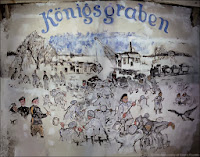My last event was the La Brea Tar Pits. It was definitely the most science-y of all the museums I visited and it felt close to home. As a Pre Human Biology and Society major taking LS1 and Society and Genetics, I knew a lot about the evolutionary processes, anthropology, and science that took place.
As I have said before, art is anything that provokes a response in viewers, such as emotions, learning, introspection, and change. I saw many forms of art in the sculptures, animal replicas, fossil presentation, and wall paintings. Using science such as anatomy, artists reconstruct bones and design and model animals that most likely resemble animals from millions of years ago. They reconstruct lineages with the fossil record of phenotypic and DNA evidence.
For example, we see the Dire Wolf which is widely known for its incredibly rich fossil deposits. The 404 sculls represent only a portion of the more than 1500 wolves whose remains have been found in LA. It is thought that packs of Dire Wolves attempted to feed on animals trapped in the asphalt and became mired themselves. Not all are exactly alike in size or shape which is why such bones are used to explain the process of evolution and natural selection.
I call these large structures of bones art because it took ingenuity and creativity to piece together each and every bone according to anatomical and physical properties. Without the advent of art to circulate attention of anatomy, like in Gray's Anatomy, people would never take interest in finding out how bones work together to create a fully functional animals with living cells, muscles, and senses. This particular mamoth has artificial tusks that were created to replicate the actual broken ones found among fossils. Advanced science and physics were necessary to calculate the weight and curvature necessary, as well as nano technologically to make pigments that match the rest of the bones. Multiple forms of science were used with collaboration to make such a stunning, scientifically accurate form of art.
In addition to multiple uses of art-science to demonstrate extinct species, artists can create scenery and set a tone for the environment. Geology is used to calculate climate and environmental shifts, so both an artists' interpretation and factual science are incorporated as a backdrop.
I believe animals and all life are art, designed by a master Creator. Both biotic and abiotic art served to excite my imagination and cause me to think deeper about the origins of life. One wall lays out the sequences of life starting from space and abstract matter, progressing to eukaryotic beings, and astronauts. It reminded me of the evolution of art and science being perceived as two separate things to what it is now - mediums that are used in conjunction to further aid each other. Art inspires many futuristic ideas that drive science to make it a reality, like space travel, and science and technology allow for new forms of art, like photography.
This was great last stop for this quarter, but it won't be my last ever. I have learned a lot of about how art, science, and technology work together this quarter, which is something I never would have thought about otherwise. I'm thankful for the opportunity to broaden my horizons, try new things, and thing about life from a new point of view. The La Brea Tar Pits really contributed to my understanding of art and anatomy in the curriculum. I would recommend that all students go to learn about science in a way that utilizes art.
Thanks for a great quarter!












































